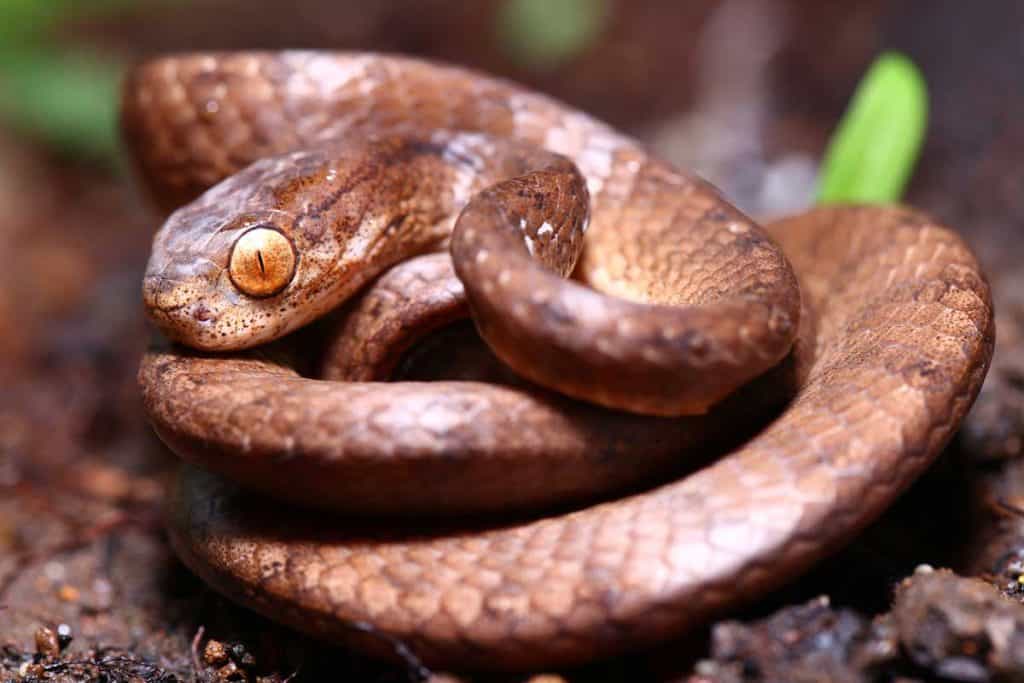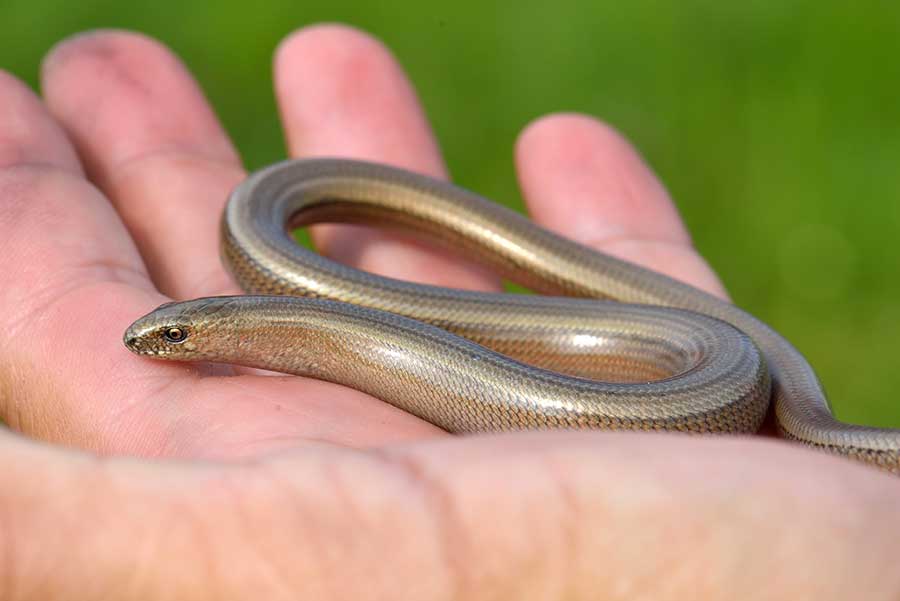Knowing how snakes poop and pee, how often it happens, what it looks like, and what it means is just as important as knowing how often you need to feed your snake!
Reptiles do not poop as mammals do, so we are not as familiar with snake poop as we may be with dog or cat poop. There is no need to worry, though, as this guide will go over snake poop basics such as frequency and ideal appearance of your snake’s bowel movements as well as when to take your snake to the vet based on its poop!
Read on to find out where snakes poop from, what snake poop looks like, how to help your snake poop more regularly, and what you need to watch out for when it comes to health concerns.
Where Do Snakes Poop and Pee From?
At the end of a snake’s body, just at the beginning of their tail, there is a small opening. This opening is called a cloaca. You may have heard it referred to as the vent as well. The cloaca is an all-purpose orifice for reptiles.
Snakes use the cloaca to poop and pee out of, but it also holds their sexual organs. Female snakes even lay eggs from their cloaca, too!
1. Cloacal Functions: Poop and Pee
Snakes poop and pee out of their cloaca. The hole might appear very small, but it can stretch a lot, especially considering the size of their poops (but we’ll get to that later)!
Your snake will defecate (poop) and urinate (pee) out of this hole. When they poop and pee, they do not struggle and posture like dogs or cats; instead, they lie very still and may move their tails from side to side.
This means once they are done, they often get a mess on their tails. As their owner, when you spot a poop, make sure you check your snake over to clean them up so they do not smell or get sick from any bacterial infections.
2. Cloacal Functions: Mating
Male and female snakes both have internal sexual organs. The cloaca protects these organs. When it comes time to mate, the male’s hemipenes will come out of the cloaca and enter the female’s cloaca to deposit sperm.
3. Cloacal Functions: Laying Eggs/Giving Birth
Females will either lay their eggs or “give birth” through their cloacas. When the eggs are ready to be laid or the live young ready to be birthed, they will all pop out of her cloaca into her nesting box or burrow.
What Does Snake Poop Look Like?
The physical appearance of poop is used by many reptile owners to get an idea of how healthy their scaly pets are and how well their metabolisms are working. From bearded dragon poop to snake poop, it is important to know what it is supposed to look like!
First, though, you should know that snakes often pee and poop at the same time. The pee can be liquid or can be solid urate attached to the solid poop. This is completely normal.
Snake poops are a lot softer than mammalian poops and are often coated in slime or mucus. This is because the poop needs to make its way out of the body smoothly in one go.
Size
Many people are shocked to find out that a snake’s poop is usually as thick as the snake’s body! The length of the poop will differ depending on the size of the meal; however, the thickness of the poop is standard to the size of the snake.
Shape
Snake poops are oblong. This means that they typically look like stretched-out balls or logs, somewhat similar to human and other mammalian poop. There should be between two and five separate segments of poop at a time.
Color
Snake poop should be a dark brown to black color with white spots or caps on it.
The brown or black part is the fecal matter. The whitish parts are known as urates, which are the snake’s pee.
Keep in mind that urate can sometimes differ in color according to different species. Talk to your breeder or vet about the ideal color of your snake’s poop!
How Often Do Snakes Poop?
Dogs and cats poop two to three times a day, while birds can poop up to 50 times a day! Snakes, however, can poop anywhere from once a week to once a month and sometimes as little as once a year!
Snakes do not poop out their meals at different times; they wait until the entire meal has been digested and nutrients absorbed, and they let the waste all go at once.
The frequency of your snake’s poops will depend on its diet and how often it eats.
For example, for a large reticulated python that has been fed a pig or a deer, it may take months to completely digest it and only poop once that year. However, rat snakes and corn snakes that eat once a week will usually poop every 5 to 10 days.
Snake Poop Is Smelly!
Snakes are the smelly protein shake gym bros of the reptile poop world. The amount of protein in their diet means that they can deliver some toxic-smelling poops!
Always clean up your snake’s poop as soon as you notice it has happened. Check your snake over to make sure they have not got any poop on them; otherwise, they will continue to smell bad and potentially develop a bacterial infection around their vent.
Snake Poop Is Host to Many Kinds of Parasites
All animals are known to have parasites in their poops at some point in their lives. People deworm their dogs (and human children) fairly often. Snakes can have parasites in their poop, too!
Hookworms, roundworms, and other parasites can find their way into your snake’s system fairly easily through contaminated substrate, food, and poor hygiene practices. Some parasites are microscopic, while others are large enough to spot with the naked eye!
Parasites can cause a variety of health problems in snakes, so they should be eliminated as quickly as possible. Speak to your local exotic vet about parasite treatments.
Ensuring Your Snake Has a Healthy Pooping Environment
There are some things that you can do to make sure your snake is pooping on a healthy schedule! Keep these measures in mind so your snake doesn’t have any issues when they need to go.
1. Make Sure Your Snake Has Enough Water
Proper hydration is essential to soft, easily passable snake poops. Make sure your snake has water available to it at all times. The water should be fresh and clean in a non-porous dish that is large and sturdy enough that it won’t tip over.
2. The Enclosure Must be the Correct Temperature
Your snake needs the enclosure to be at a certain temperature for their metabolism to work properly. Therefore, if your snake has not pooped in a while, check your heat settings. The enclosure may be too cold for your snake to digest its food. Different snakes have different temperature requirements, so make sure the temperature is right for their species.
3. Keep Your Snake on the Correct Diet
Feeding your snake appropriately-sized prey items of good quality will help them form healthy poops! Make sure you do not try to feed your snake things that are not appropriate to its diet such as fruit or insects. Snakes are carnivores, so they can only eat animal matter.
4. Soak Your Snake Often
Soaking your snake regularly, or around once a week, will help it stay hydrated as well as help it digest its food and poop smoothly. Place your snake in a shallow tub of water that is the same temperature as the slightly warmer side of the enclosure.
Keep an eye on the temperature of the water! If it gets too cold, you can seriously harm your snake by lowering their body temperature.
Soaking feels so good to snakes that many just poop right there in the water! If this happens, remove your snake once it is done pooping, and gently wash them off to make sure none of the poop is stuck to them.
Poop Clues to Watch out for
1. Impaction/Constipation
If your snake is not pooping and you are very worried, they may be constipated or suffering from impaction. Soak them and keep them well hydrated. If they have not pooped in the day following a good soak, you should take them to the vet!
2. Strange Colors
Bright yellow, blue, green, red, or orange poop is a sign that something is wrong with most snakes. This indicates that there is an internal infection, and they should be taken to the vet soon.
Red-colored poops mean that there is fresh blood in the digestive tract. This is from the snake and not from their prey.
FAQs About Snake Poop
The cloaca is at the end of the body and the beginning of the snake’s tail… But I thought snakes were all heads and tails?!
Snakes have separate bodies and tails! The body is separated at the cloaca where the body contains internal organs, and the tail is all muscle.
Is musk the same thing as peep and poop?
Musk is not poop or pee, even though it does not smell great, either.
Will my snake poop during brumation?
Reptiles generally do not eat during brumation because their metabolism is too slow. If they do not eat, then they will not poop.
Make sure your snake has had a successful poop before brumation and enters brumation on an empty stomach. If a reptile undergoes brumation while they have food in their digestive tract, then there is a risk of the food rotting and poisoning the reptile from the inside.
Not sure what brumation is? Not to worry–we have got you covered! Check out our guide on brumation here.
Slithering Off…
How do snakes poop? Now you know the answer to this question. Learning about your snake’s poops, how they poop, when they poop, how often they poop, and what snake poop should look like is important if you want to take good care of your pet.
Poop holds many clues about the overall health of your snake and should be paid attention to!
You will eventually get to know your snake’s pooping schedule. It may help to keep a poop diary for them so you definitely know when something is off. This way, you can also show the diary to your vet so they can pinpoint any irregularities.




